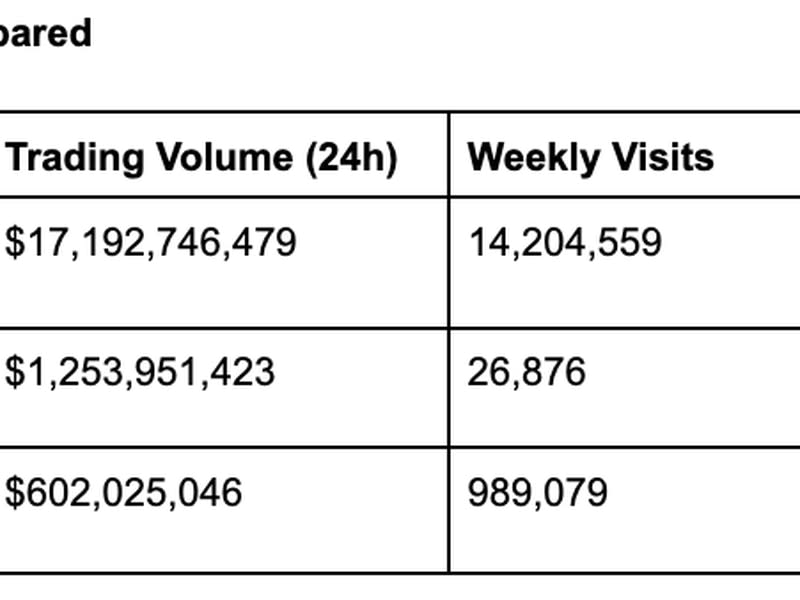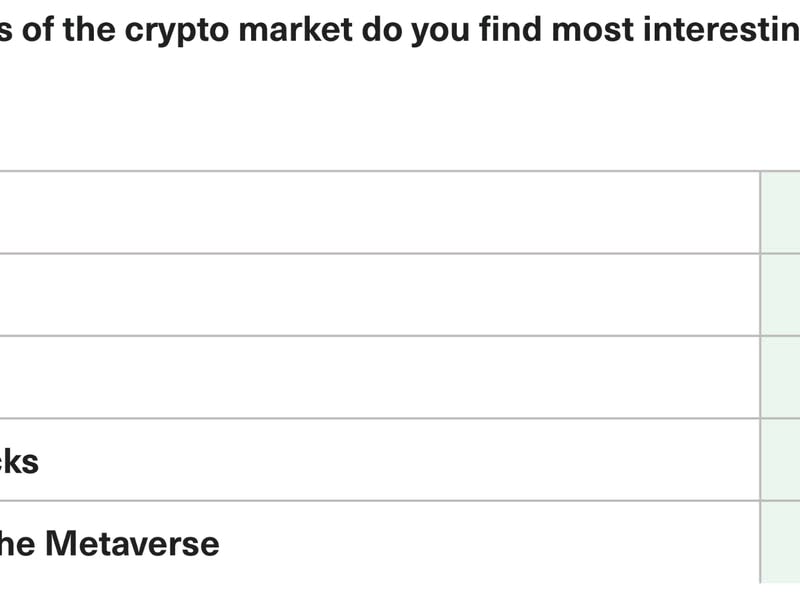Crypto Long & Short: Decentralized Exchange Research Ramps up
Join the most important conversation in crypto and web3! Secure your seat today
This week, Glenn Williams Jr. argues that decentralized exchanges (DEX) have an intriguing road ahead amid the wreckage of FTX.
Then, Kelly Chambers of THEIA8900 notes the digital-asset myopia among financial advisers focused on bitcoin (BTC) and Ethereum’s ETH.
You’re reading Crypto Long & Short, our weekly newsletter featuring insights, news and analysis for the professional investor. Sign up here to get it in your inbox every Wednesday.
Centralized Exchange Scrutiny Will Spur Research of Decentralized Exchanges
The push following the FTX exchange’s collapse to regulate centralized crypto exchanges will likely be a net positive for those looking to expand their understanding of crypto. I don’t say that as someone who advocates for or against regulation, but as someone who expects crypto participants to adapt as the environment shifts.
I recognize the importance of regulation, but am sometimes skeptical of the motivations behind it. I also live on Earth, more specifically New Jersey. So I walk around with the underlying assumption that regulation, like bad traffic, is largely unavoidable.
On Feb. 9, we saw Kraken agree to shutter its U.S. crypto-staking operations and pay a $30 million fine to the Securities and Exchange Commission.
On Feb. 23, the SEC objected to Binance.US’ deal to purchase assets of now-defunct crypto lender Voyager Digital.
Coinbase faces scrutiny, too, having to publicly state that its staking products are “fundamentally different” from the yield products Kraken was forced to stop offering.
All three things involve centralized exchanges (CEX). That root word “central” sure looks like a regulatory bullseye now.

When I was early in my crypto journey, centralized exchanges served as a welcome on-ramp where I could set up an account, link to a bank account (letting me easily bring fiat money into the digital asset realm) and then press a button and see that I’d just purchased bitcoin (BTC). I also provided loads of personal information during the Know-Your-Customer (KYC) process.
For purists, this all runs completely counter to the crypto ideal of decentralized, trustless, peer-to-peer transactions. I actually think the existence of centralized exchanges is a positive. For many investors it represents a comfortable way to gain access to this space, via an accountable entity. I expect them to stay.
But I also expect that the recent crackdown – and, in all candor, I think some of the increased scrutiny has been earned following the bankruptcy of FTX – will accelerate the learning curve for those willing to dive into decentralized exchanges (DEX), which operate very differently from anything you see in traditional finance (TradFi).
As an investor, my interest would not just be in the exchanges themselves, but also the tokens associated with them and their economics. For market-centric people from the TradFi world – as I am – that requires a certain level of commitment to learning the technical differences behind many of these protocols.
Certain fundamental attributes are certainly worth paying attention to. For starters, with DEXs you will largely be dealing with code as opposed to humans. Math as opposed to management. Unlike crypto CEXes, DEXes do not really resemble the New York Stock Exchange or Nasdaq.
Decisions that management teams make within CEXs are instead handled at DEXs through a vote among token holders. Governance is enforced in a trustless and decentralized manner.
For point of reference, the largest DEX by market capitalization is Uniswap. The $5 billion market cap of its UNI token pales in comparison to Binance’s BNB token ($48 billion). In a sense this illustrates the potential opportunity that exists within the DEX landscape.

The distribution of capital from DEXs also presents some interesting opportunities. Akin to stock buybacks in the traditional world, DEXs will often distribute value back to token holders via a token burn, or a token buy back and burn. In short, the objective is to reduce the supply of the asset, which (when supply and demand dynamics hold true to form) lend to increased values for the asset.
In fairness, this is done by both centralized and decentralized exchanges. The distinction with DEXs, however, is that while a CEX has to consider the interest of both individual shareholders and token holders, no such conflict exists within DEXs.
There is no company president or management team to consider. Only the token holders themselves, who can often vote for or against the payment mechanism. The decision is up to the network itself.
DEX tokens often provide incentives to holders on the basis of yield generation, reduced trading fees and governance. As the demand for usage of the network increases, the value of the asset is likely to as well, without the overhang of malfeasance, and the extreme target of regulators (at least for now).
All told, increased scrutiny of centralized exchanges will likely lead to increased knowledge and adoption of decentralized ones. In many ways, this aligns closer with the original Bitcoin white paper, which in large measure kicked everything off.
Weekly Challenge: The Digital Asset Power Hour
Understandably, crypto regulation is getting a lot of attention. But for investors looking to allocate capital over a longer horizon, focusing too much on tracking legislation and industry legal woes may be a distraction to long-term success.
So what’s an investor to do when news headlines are luring us in with who Securities and Exchange Commission Chair Gary Gensler is after or what Kevin O’Leary thinks of the SEC? Start a weekly challenge, of course!
I call it the Weekly Digital Asset Power Hour.
I know a lot of financial professionals who block off time for “research” (aka reading news). The challenge is to dedicate at least one of those hours per week to learning about a digital asset. CoinDesk’s Digital Asset Classification Standard has 500 assets waiting for you. (If this at all sounds boring, remind yourself that Warren Buffett has long done this with 10-Ks – oof.)
The more you understand the use cases of individual assets, the better you can diversify beyond bitcoin (BTC) and Ethereum’s ether (ETH), whether that be selecting individual assets or taking an index approach. The data suggests that it may also give you a competitive edge.
For example, Bitwise recently surveyed financial advisers. One of the questions made me hesitate. The question was: Which areas of the crypto market do you find most interesting?

As I looked at the answers, noting BTC and ETH’s dominance with Web3 and the metaverse way behind, I could not help but think, “Are the advisers really answering the question as it’s worded?” Bitcoin is the largest digital asset, but most interesting? I think they were subconsciously actually answering this: What part of crypto do you understand best? Humans tend not to be interested in things we don’t understand, especially when technical. (Don’t ask me to explain how my iPhone works. I am not interested.)
A follow-up question reinforced my inkling. Most advisers are getting their crypto education from traditional media, which focuses on BTC, ETH, regulation and the latest news on the Sam Bankman-Fried saga.

Why does this matter? It suggests some of the most sophisticated investors – financial advisers – lack broad knowledge of digital assets.
Jennifer Murphy, the CEO of Runa Digital Assets, wrote in a previous version of this newsletter: “Long-term investors would do well to make sure their portfolios include the potential wealth creators that will disproportionately drive market returns in the coming decades.”
The “potential wealth creators” are the crypto use cases that will survive and thrive over the next decade. And one could argue that assets other than BTC and ETH may be larger wealth creators given that being newer means they have a longer growth runway.
For example, take the once buzzworthy metaverse, part of CoinDesk Indices’ Culture & Entertainment sector. Far less attention is now being paid to the metaverse and its underlying digital assets. Yet, recent data from Statista reports that the metaverse could have $490 billion in market revenue by 2030, up from $45 billion in 2022.

The metaverse is vast and evolving. Brands like Starbucks and the National Basketball Association are testing digital experiences. BlackRock just launched a metaverse exchange-traded fund (ETF). Venture capital firms like Pantera and a16z are still throwing millions of dollars at metaverse startups, funding the industry's growth.
There are 50 assets in CoinDesk Indices’ Metaverse industry group, all with different use cases. Not a bad place to start your digital asset power hour. Cheers.
– Kelly Chambers of THEIA8900, a fintech and crypto consultancy
Takeaways
From CoinDesk’s Nick Baker, here’s some recent news worth reading:
BITCOIN BUILDERS: Despite the Bitcoin blockchain’s influence and giant size, an excellent CoinDesk piece explores the potentially shaky ground beneath its development amid the crypto winter. It comes down to money: Will there be enough to pay the people who maintain the infrastructure? While it’s hard to believe Bitcoin will be left out to dry, the fact that such a story needs writing tells you just how chilly it’s gotten out there.
NBA MESS: NBA Top Shot is a non-fungible token (NFT) collection that lets basketball fans collect video clips from games. Innocuous stuff, you might think. Just like paper trading cards of yore? Well. A judge just ruled there’s reason to believe they could be securities. The kind of things that need to be registered, with paperwork and such, like stocks or bonds. Satoshi Nakamoto’s fun little experiment keeps slamming into the mountain of conventional financial regulation.
ARBITRUM ASCENDS: One of the hot stories of 2021 was how Solana would bring to crypto the industrial-grade transaction processing capacity that conventional markets, finance and banking was accustomed to. The biggest smart contract-based blockchain, Ethereum, the thinking went, just wasn’t up to the task. Plain-vanilla Ethereum remains relatively slow and expensive; Visa or the New York Stock Exchange aren’t turning to it anytime soon. And while Solana has not made major progress, in recent months scaling up Ethereum by offloading transactions to related platforms has gotten traction. And one of them, Arbitrum, just hit a milestone: it handled more transactions in a 24-hour period than Ethereum. This could be the future for resource-intensive projects.
FTX HFT: Folkvang is a high-frequency trading firm that got hurt by FTX’s collapse. Much of its money was tied up there. While it’s not holding its breath waiting to get any of it back, the company is still standing. "We learned a hard lesson with FTX," founder Mike van Rossum said in a recent interview. "We found that risk is real. We thought it could never really happen in the way it did, so we are a lot more risk averse now."
To hear more analysis, click here or here for CoinDesk’s “Markets Daily Crypto Roundup” podcast.


